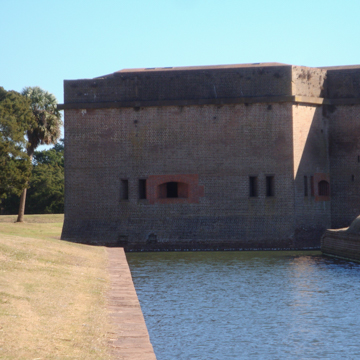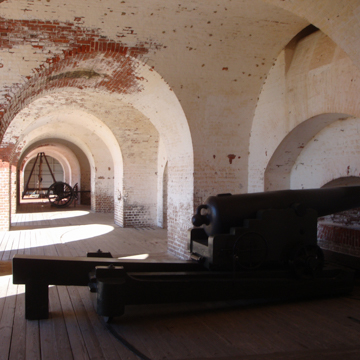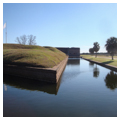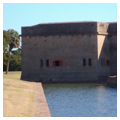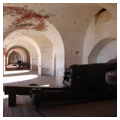You are here
Fort Pulaski National Monument
Fort Pulaski is one of almost thirty surviving “Third System” coastal fortifications built after 1816. It is located on Cockspur Island, an islet in the tidal marshland just above Tybee Island at the mouth of the Savannah River, where grassy isles divide the two channels of the river. Considered by one of Georgia’s colonial governors to be the “key to our province,” twenty acres on the island’s eastern point have been fortified since the eighteenth century. From here, troops guarded the river and the town of Savannah, Georgia’s first settlement, which is located twenty miles upriver. Though Cockspur is where John Wesley, founder of Methodism, first set foot on American soil, the island is at least as significant for its place in the history of fortifications.
After his election as the first president of the United States, George Washington introduced a national defense policy that recognized the need for coastal defenses. In response, a second fort was built on Cockspur Island in 1794–1795, this time named in honor of General Nathanael Greene, Revolutionary War hero and resident after the war of nearby Mulberry Grove Plantation. Fort Greene was designed with a guardhouse and a battery for six guns, but was otherwise a basic timber and earth fort enclosed by pickets. When a powerful hurricane swept across Cockspur Island in the fall of 1804, Fort Greene was completely destroyed. The Savannah River lay exposed again, for a quarter century, as was most of the Atlantic coast during the early nineteenth century.
During the War of 1812 that vulnerability was made clear when the British invaded and burned Washington, D.C. At the war’s end, President Madison urged Congress to appropriate funds for coastal fortifications to complete those already started and to extend the system. This occurred just as General Simon Bernard, a French fortification and military engineer and graduate of the Ecole Polytechnique in Paris, was seeking employment in the United States. Highly recommended by the Marquis de Lafayette and Albert Gallatin, Bernard was commissioned in the American Corps of Engineers as a brigadier general and joined a newly-formed Board of Engineers charged to devise a system of seacoast defenses for the entire country.
By 1821, when President James Monroe had secured funding for surveys and construction of coastal forts, Cockspur Island was selected as a site for a major fort, based on surveys of river approaches to Savannah. The first set of plans Bernard approved in 1827 were unsuitable due to the projected weight of a two-story structure mounting three tiers of guns. Plans were adjusted, an improved foundation plan of heavy wooden piles and grillage to support brick walls was approved, and construction began on Fort Pulaski in early 1829 with Major Samuel Babcock of the Corps of Engineers in charge. By the end of 1829, newly commissioned Robert E. Lee arrived on Cockspur Island from West Point to report for his first military assignment.
Due to Babcock’s ill health, Lee supervised much of the early work, beginning the system of drainage and dikes and surveying and finalizing the construction site for the fort. By 1831 Babcock was relieved by Lt. Joseph K. F. Mansfield, who served at Fort Pulaski from 1831 to 1845, and to whom credit for construction must be assigned. By 1847 an estimated twenty-five million bricks had been laid by enslaved laborers rented from the owners of nearby rice plantations along with paid masons and carpenters from Savannah and the North. Work stoppages during summer months were frequent due to the danger of malaria, yellow fever, typhoid, and dysentery. By the outbreak of the Civil War, costs to build and arm the fort had risen to almost a million dollars, but of the 146 projected guns, only twenty had been mounted, and there were no soldiers yet garrisoned.
When Abraham Lincoln was elected president in November 1860, Southern secessionists began to encourage withdrawal from the Union. These included Georgia governor Joseph E. Brown, who began preparations for defense of his state in the event of conflict with federal troops. South Carolina seceded from the Union in December 1860, and a convention in Georgia was scheduled for January 16, 1861 to determine the future course for Georgia. In Charleston federal troops occupied Fort Sumter on December 26, the very night citizens of Savannah, carrying torches through the streets and squares of the city, were celebrating South Carolina’s secession. News of the federal occupation of Fort Sumter reached Savannah the next day. Fearing that the federal troops would occupy all coastal forts, the citizens of Savannah decided to seize Fort Pulaski. On the evening of January 1st, after consulting with military leaders and influential citizens of Savannah, Governor Joseph E. Brown ordered the State militia to seize Fort Pulaski. There was no one at the fort to oppose this action, but neither was the fort in any condition for defense.
When the Civil War began in April after the attack on Fort Sumter, Georgians still occupied Fort Pulaski. Despite the impenetrable appearance this massive brick fortress conveyed, it would soon make military history by demonstrating its inability to withstand attack by modern rifled cannons. The new technology of rifled guns led some to doubt Pulaski’s real strength from the start. On the first of May, 1861, a correspondent of the London Times accompanied an inspection tour of the fort by military men, and wrote this in his diary: “they do not understand the nature of the new shells and heavy vertical fire, or the effect of projectiles from great distances falling into the works…What I saw did not convince me that Pulaski was strong, or Savannah very safe.” By mid-summer, the North was already planning its naval blockade of the South and stood ready to recapture southern coastal fortifications, including Pulaski. Robert E. Lee, now a brigadier general in the Confederate Army, arrived to defend Savannah.
Lee realized that without Confederate naval support, smaller forts on coastal islands could not be defended, and troops that might be garrisoned there were badly needed elsewhere in the fight. He ordered the abandonment of Tybee Island and moved its guns and two companies of infantry to Fort Pulaski. Conventional thinking was that Pulaski could defend itself from naval attack or land bombardment, given the immediate marsh surroundings. Ships couldn’t get near enough, and there was not firm ground near Pulaski on which to erect land batteries closer than Tybee Island, between one and one-and-a-half miles away. Pulaski’s brick walls were seven-and-a-half feet thick backed by massive piers. Military experience suggested that smoothbore guns and mortars shot from a distance more than 700 yards would have little effect.
William T. Sherman’s Chief Engineer, Captain Q. A. Gillmore, had different ideas. He was familiar with the new rifled guns, tested since 1859, and Gillmore reported to Sherman that with new rifled cannons, he could reduce Pulaski with mortars and rifled guns shot from Tybee Island over a mile away. Sherman was anxious to capture Savannah, so he sent Gillmore to command the federal troops on Tybee Island and to prepare for the bombardment of Fort Pulaski. Between late February and early April Gillmore’s men began erecting some eleven batteries on the northwest shore of Tybee Island, facing Fort Pulaski. On April 10th, federal forces invited the Confederates occupying Fort Pulaski to surrender unconditionally; they refused and the bombardment began.
The Tybee bombardment soon flaked away much of the entire height of Fort Pulaski’s wall at the southeast angle, penetrating the brick from two to four feet in depth. Soon two large holes were opened through the walls, and troops on Tybee could see the inside of the fort. Projectiles from rifled guns could now be fired through the breach; they swept across the parade grounds and struck the walls of the north magazine, where 40,000 pounds of black powder was stored. By the end of the second day of bombardment, the commander of Fort Pulaski reluctantly surrendered. As Ralston Lattimore has written, when the Confederate flag was lowered and a white flag went up over Fort Pulaski, “an old era in coastal fortifications had come to an end.”
Not only did the Northern occupation of Fort Pulaski allow federal troops to control the entrance to the principal port of Georgia, but it also signaled needed changes in fortification design. As General Hunter observed in his report to the Secretary of War, “The result of this bombardment [of Fort Pulaski] must cause a change in the construction of fortifications as radical as that foreshadowed in naval architecture by the conflict between the Monitor and Merrimac. No work of stone or brick can resist the impact of the rifled artillery of heavy caliber.” During two days of bombardment at Fort Pulaski, federal troops had fired 5,275 shot and shell against the fort, but the breach through the brick walls was largely the result of three rifled guns—two 80-pounder and one 64-pounder James rifles. A solid projectile shot from these rifled guns almost a mile away penetrated the brick wall.
Federal troops continued to occupy Fort Pulaski until the Civil War ended. Between October 1864 and March 1865, the fort served briefly as a military prison, where prisoners were kept in deplorable conditions. Some post-war improvements were made to the structure between 1869 and 1872, including remodeling the demilune, constructing underground magazines and passageways, and building emplacements for heavy guns. A new coastal artillery post on Tybee Island prompted the cessation of further military activity at Fort Pulaski. Other than the garrisoning of a small force during the Spanish American War, no further military use of Fort Pulaski occurred after 1872.
Fort Pulaski became a National Monument in 1924. Continued deterioration ensued until 1933 when the fort was transferred from the War Department to the Department of the Interior. Restoration, funded by the Public Works Administration, was completed by the Civilian Conservation Corps; Fort Pulaski’s revitalization created a large-scale outdoor exhibit, now open to the public. Pockmarks from the bombardment are still visible in the brick surfaces of the outside walls.
References
Lattimore, Ralston B. Fort Pulaski National Monument, Georgia.Washington, D.C.: National Park Service, 1954.
Writing Credits
If SAH Archipedia has been useful to you, please consider supporting it.
SAH Archipedia tells the story of the United States through its buildings, landscapes, and cities. This freely available resource empowers the public with authoritative knowledge that deepens their understanding and appreciation of the built environment. But the Society of Architectural Historians, which created SAH Archipedia with University of Virginia Press, needs your support to maintain the high-caliber research, writing, photography, cartography, editing, design, and programming that make SAH Archipedia a trusted online resource available to all who value the history of place, heritage tourism, and learning.


